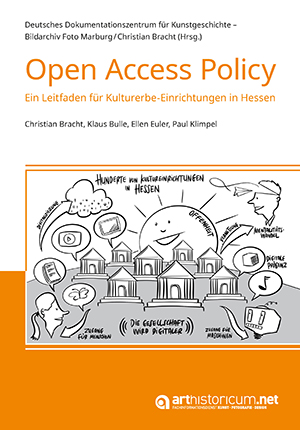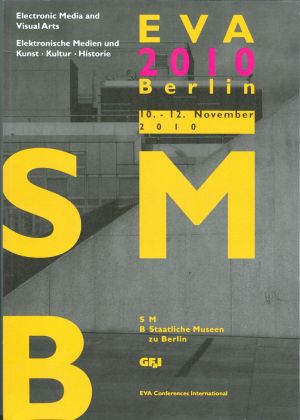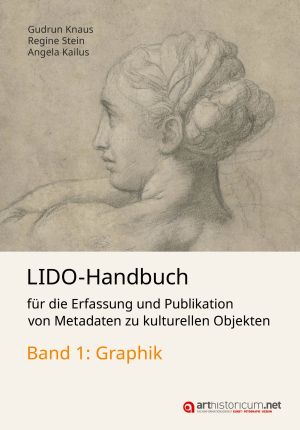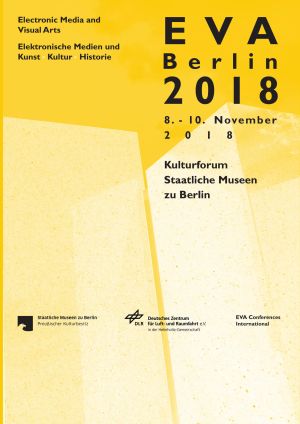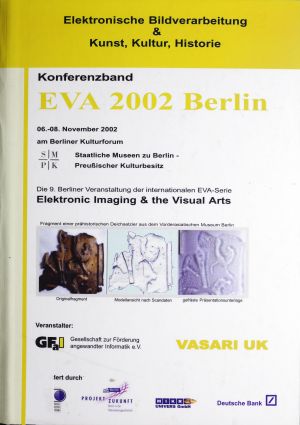Bracht, Christian
Konferenzband EVA 2011 Berlin Elektronische Medien & Kunst, Kultur, Historie: Die 18. Berliner Veranstaltung der internationalen EVA-Serie Electronic Imaging & the Visual Arts (u. a. EVA London, EVA Florence, EVA Moscow & EVA Berlin)
Leitfaden für digitales Sammlungsmanagement an Kunstmuseen
Der Leitfaden dient als Einstieg in das Thema Digitalisierung an Kunstmuseen. Er setzt den Fokus auf das digitale Sammlungsmanagement und erläutert alle Arbeitsschritte rund um die computergestützte Dokumentation einer Sammlung und die anschließende Vernetzung der Daten in sammlungsübergreifenden Portalen. Dabei baut der Leitfaden auf international etablierte Standards sowie auf unmittelbare Arbeitserfahrungen der Autoren auf. Die idealtypischen Empfehlungen können jeweils auf die individuellen Bedürfnisse und Voraussetzungen eines Museums, gleich welcher Gattung und Größe, angepasst werden. Wertvolle Praxistipps und Literaturempfehlungen machen ihn zu einem nützlichen Arbeitsinstrument.
Open Access Policy: Ein Leitfaden für Kulturerbe-Einrichtungen in Hessen
Kultureinrichtungen verfügen über umfangreiche Kulturgüter, die einen universellen und überzeitlichen Wert haben. Die Digitalisierung vereinfacht den Zugang und erweitert und vervielfacht die Nutzbarkeit des von diesen Einrichtungen verwalteten Kulturschatzes. Der offene Zugang wird jedoch häufig durch rechtliche, technische oder finanzielle Beschränkungen stark behindert.
Daher haben sich im Jahr 2021 die wichtigsten Kulturerbe-Einrichtungen des Landes Hessen zu einer gemeinsamen Open Access Policy verpflichtet. Der vorliegende Leitfaden erläutert diese Policy und gibt Mitarbeitenden in Kulturerbe-Einrichtungen – nicht nur in Hessen – praktische Hinweise, wie sie umgesetzt werden kann.
Konferenzband EVA 2010 Berlin: Elektronische Medien & Kunst, Kultur, Historie. 10. - 12. November 2010 in den Staatlichen Museen zu Berlin am Kulturforum Potsdamer Platz
Die 17. Berliner Veranstaltung der internationalen EVA-Serie Electronic Imaging & the Visual Arts (u. a. EVA London, EVA Florence, EVA Moscow & EVA Berlin)
LIDO-Handbuch für die Erfassung und Publikation von Metadaten zu kulturellen Objekten: Band 1: Graphik
Band 1 des LIDO-Handbuchs mit dem Schwerpunkt Graphik entstand in enger Kooperation mit den Mitgliedern des internationalen Arbeitskreises Graphik vernetzt. Um Daten aus verschiedenen Erfassungssystemen in Museen und Bibliotheken auf sammlungsübergreifenden Plattformen zusammenführen zu können, müssen gemeinsame Standards für Dateninhalte und die Datenstruktur angewendet werden. Der vorliegende Leitfaden listet alle relevanten Datenfelder für die Beschreibung von Zeichnungen und Druckgraphik auf. Jedes Datenfeld wird definiert und enthält Tipps für die Erfassung, inhaltliche Beispiele sowie Hinweise, die beim Datenexport im LIDO-XML-Format zu beachten sind.
LIDO-Handbuch für die Erfassung und Publikation von Metadaten zu kulturellen Objekten: Band 2: Malerei und Skulptur
Band 2 des LIDO-Handbuchs widmet sich Objekten der Gattungen Malerei und Skulptur. Es handelt sich dabei um ein Anwendungsprofil des international etablierten Metadatenstandards LIDO (Lightweight Information Describing Objects), das als Anleitung für die schlüssige Strukturierung von Informationen in lokalen Sammlungsmanagement-Systemen dient. Jedes Datenfeld enthält eine Definition, Tipps für die Erfassung, Beispiele sowie Hinweise, die beim Datenexport gemäß des LIDO-XML-Schemas zu beachten sind. Sämtliche Empfehlungen dienen dem Ziel, Daten aus unterschiedlichen Quellen so aufzubereiten, dass möglichst umfassende und präzise Suchergebnisse erzielt und Wege zur weiteren Informationsvernetzung eröffnet werden können.
Konferenzband EVA Berlin 2015. Elektronische Medien & Kunst, Kultur und Historie: 22. Berliner Veranstaltung der internationalen EVA-Serie: Electronic Media and Visual Arts
Konferenzband EVA Berlin 2018. Elektronische Medien & Kunst, Kultur und Historie: 25. Berliner Veranstaltung der internationalen EVA-Serie Electronic Media and Visual Arts
Die 25. EVA Berlin Konferenz [Electronic Media & Visual Arts] fokussiert den Spannungsbogen zwischen materiellem Kulturerbe und virtueller Repräsentanz. «Digitale Zwilling» verändern die Praxis des Kuratierens, der wissenschaftlichen Dokumentation und der Vermittlung. Sie begründen breitere Zugänge zu den Sammlungsbeständen und innovative Verfahren der Visualisierung und Narration. Als E-Installations oder Streamingdienste sichern sie den performativen Künsten Dauer und ermöglichen originale Klangerlebnisse in der digitalen Konzerthalle.
Konferenzband EVA 2002. Berlin Elektronische Bildverarbeitung & Kunst, Kultur, Historie: Die 9. Berliner Veranstaltung der internationalen EVA-Serie Electronic Imaging & the Visual Arts (u.a. EVA London, EVA Florenz, EVA Moskau, EVA Gifu & EVA Berlin)
Konferenzband EVA 2005 Berlin. Elektronische Bildverarbeitung & Kunst, Kultur, Historie: Die 12. Berliner Veranstaltung der internationalen EVA-Serie Electronic Imaging & the Visual Arts





